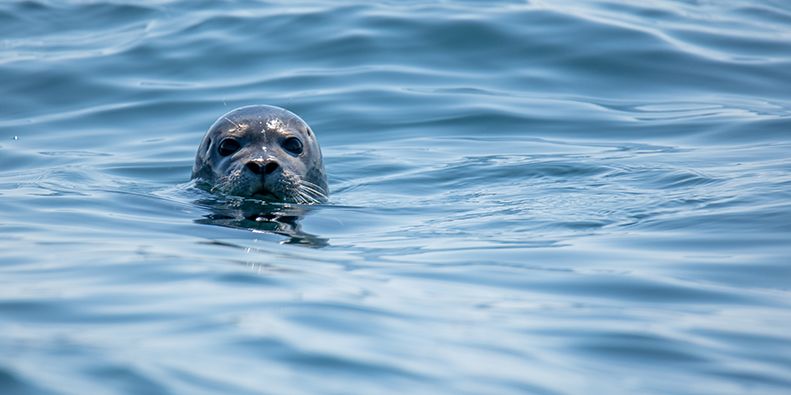Quiet success for pioneering acoustic deterrents
05 April 2021

One of the biggest challenges for fish farmers is protecting their stock from predators while also minimising the impact on the marine environment.
From May 2019 to May 2020 more than half a million farmed salmon in Scotland died as a result of seal attacks, either directly or indirectly from stress after being subjected to an attack, according to the Scottish Salmon Producers Organisation (SSPO).
Despite the millions of pounds invested in infrastructure, net pens are never 100 per cent secure from the most determined seals, and farmers must find other means of keeping their fish safe.
The licensed shooting of seals as a last resort was outlawed in Scotland earlier this year to comply with the US Marine Mammal Protection Act (MMPA) that bans fish imports from countries that injure or kill marine mammals during production.
The focus now is on non-lethal anti-predation methods, with a combination of reinforced nets, good farming practices and safe acoustic deterrents.
Ace Aquatec has two world-leading acoustic deterrents that are 100 per cent compliant with MMPA welfare criteria and have proved highly effective over years of use compared to other traditional acoustic devices in the market.
In Scotland, salmon farmers announced in March that they would no longer use ADDs that could cause disturbance or injury to European Protected Species (EPS), in line with new legislation being introduced by Marine Scotland. The change to the Scottish rules will require EPS licences for work which may disturb or injure species such as dolphins and porpoises, and is aimed at addressing the old style of acoustic deterrent devices which often operated at loud average volumes and higher repetitive frequencies.
Ace Aquatec’s deterrents, which meet the requirements from Marine Scotland for modulated frequencies and low average volumes and can be deployed without EPS licences, are clearly audible to target species, such as seals, but are less audible to protected cetaceans.
Nathan Pyne-Carter, chief executive of Ace Aquatec, said:
‘Scottish fish farmers have a legal and moral duty to protect the welfare of their fish and the losses caused by seal attacks can have a significant financial and operational impact on a key Scottish sector.'
‘We began making deterrents back in 2001 when we purchased the aquaculture interests of Ferranti Thomson, and released our first low average volume system which utilised the acoustic characteristics of a 10 millisecond rise time, which elicits a startle reflex in mammals. This work was carried out by Ferranti Thomson’s engineers and scientists during the 1990s, based on original rat studies by Morten Flesher in 1965.'
‘Our triggered system used a low volume training noise which was generated whenever fish became spooked by seals, and after this training pulse we played a series of 10 millisecond pulses of random frequencies to cause a startle in seals.This system was in stark contrast to the prevalent deterrents at the time, which worked on the basis of creating painful volumes continually. The latter were associated with habituation, deafness issues and caused ADDs to become banned in British Columbia, Canada, and in Australia.'
‘Since this early system, we went on to map the frequency spread to the hearing thresholds of the target species (RT1s uses random startle pulses at 0.8-2khz, and the US3 uses 8-11khz pulses), and then to develop artificial intelligence (AI) detection triggers, which have been developed to spot the difference between seals, porpoises and whales.’
Pyne-Carter added: ‘This year, the development of environmentally responsible deterrents has become more critical as MMPA compliance and Marine Scotland considerations for EPS licensing mean low average volume systems are the only ones permissible in Scotland, and in other US exporting countries.’
Ace Aquatec received a SAIC (Sustainable Aquaculture Innovation Centre) award in 2016 for its ADD innovations, and a Queen’s Award for Enterprise Innovation in 2018. The company has begun working with Scottish Sea Farms to roll out its AI triggers, as well as its electric fish (developed to create conditioned avoidance when paired with the acoustic system) and is just in the process of getting ASC (Aquaculture Stewardship Council) variance requests approved for its deterrents.
Funding has been announced from CEFAS for the AI trigger roll-out, and from SAIC for a project with St Andrews University. This will map the characteristics of Ace Aquatec deterrents and explore the efficacy of the triggering system, while a follow-on grant lined up with SAIC will increase knowledge of deterrent sound propagation in Scotland.
Ace Aquatec also builds the Fauna Guard deterrent system which was validated by research from Ron Kastelein and is the only deterrent with European approval in pile driving contexts.
‘We are pleased that our devices have secured MMPA compliance and we are committed to working with the Scottish marine and aquaculture sector for further research into the use of ADDs and animal safety,’ said Pyne-Carter.


